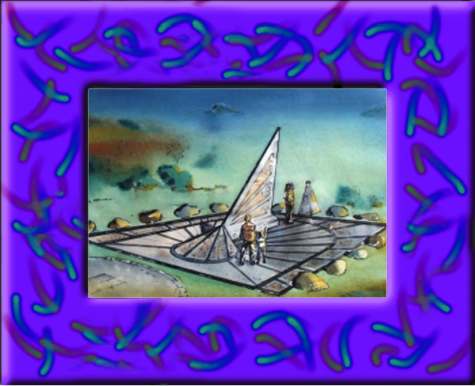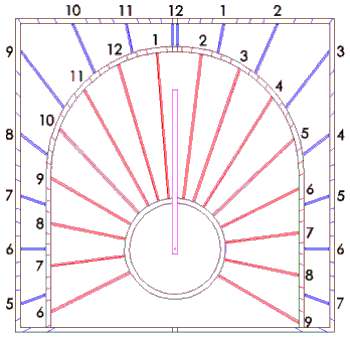
| HOME |
| SUNDIAL |
| SITE |
| THE PROJECT |
| MY DIAL |
| FUNDRAISING |
| LINKS |
|
| IMPORTANT DIALLING STUFF |
| INTERPRETIVE GUIDE 500kb |
| You will be downloading a zip file that has a pdf file of the brochure. |
| Check out the interpretive display installed in 2003. |
| The Project | |
The Pinawa Heritage Sundial is a horizontal sundial. This is the type of sundial that you would find at a garden centre, however, you would not likely find one this large. This type of sundial has a horizontal dial plate and a gnomon which points to the north celestial pole. A horizontal sundial must be designed for the latitude at which it is located and the angle of the gnomon is equal to the local latitude. The dial actually consists of two sundials on a single dial plate. This can be seen in the illustration below. The hour lines for the two dials are shown in blue and red. The gnomon is shown and has its origin at the centre of the circle and extends toward 12:00 on the outer dial. The outer dial with the blue hour lines shows "local apparent time". This is solar time as derived from the real sun at the sundial's location. The inner dial with the red hour lines shows "zonal solar time". This is the "local apparent time" corrected for the longitude at the sundial's location. This correction is necessary because the sundial is not located on the central meridian of our time zone. |
|
 |
|
| One
further correction must be applied to the reading
obtained from the inner dial to obtain
"civil" or "clock" time,
which is the legally accepted time scale at a
particular location. This correction is known as
the "Equation of Time". The EoT value
varies between the extremes of +14 minutes in
February to -16 minutes in November. The EoT is
the result of two factors; the elliptical orbit
of the earth and the tilt of the earth's axis to
the ecliptic. The ecliptic is the plane that the
earth's orbit traces during a year. There are two additional features to note in the illustration. The first is that the hour lines of the inner dial have been adjusted to read "Daylight Saving Time". This is simply a matter of adding one hour to each of the times. The second may be more difficult to notice but a "noon gap" has been applied to the hour scale of the dial to account for the finite thickness of the gnomon. Because the gnomon does have thickness the shadow falling on the dial plate will originate from a different edge at various times of the day. Before 6:00 a.m. "local apparent time" (LAT), the shadow will be cast from the east edge of the gnomon; between 6:00 a.m. and noon LAT the shadow will be cast from the west edge of the gnomon; between noon and 6:00 p.m. LAT the shadow will be cast from the east edge of the gnomon and finally after 6:00 p.m. the shadow will be cast from the west edge of the gnomon. Noon LAT will be cast from both edges of the gnomon and, therefore, this is where the gap is applied. If you go to "MY DIAL" you will see that the dial has a noon gap and is adjusted for both longitude and Daylight Saving Time. There is a graph which illustrates the Equation of Time which can be used to apply the final correction required to obtain clock time. When visitors come to the sundial, they will receive an interpretive guide. This guide contains information about the sundial and how to tell the time using the dial. The guide also contains images of all the icons along with the description of each one. These descriptions are also found on this site in the "ICONS" pages. |










